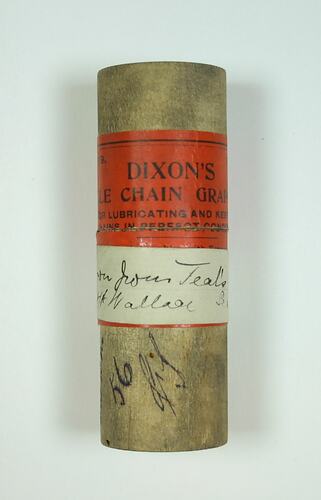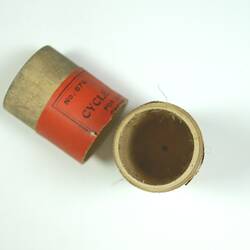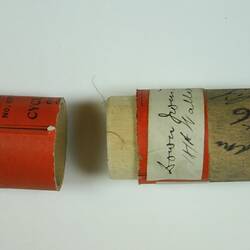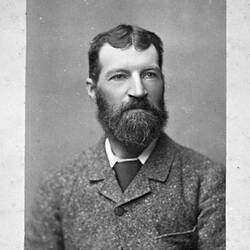Summary
Wooden cylindrical container, originally housing Dixons 'Cycle Chain Graphite', used to maintain bicycle chains, but subsequently used by keen cyclist and field naturalist A.J. Campbell to store down from a Chestnut Teal Duck, which was collected from a nest during the 1899 collecting season. Later the Science Department at Museum Victoria used the container to store eggs in their collection. The container still houses some remnant Chestnut Teal Duck down.
Physical Description
Wooden cylindrical container with detachable wooden lid, originally housing Dixons 'Cycle Chain Graphite'. The container has a red sticker which is original packaging information about the Dixon's graphite. Over the top of this is a white sticker with handwritten notes about the collection of duck down. The container contains some remnant Chestnut Teal Duck down.
Significance
This wooden cylinder has several histories, one as a container for a bicycle maintenance product, another history as a storage container for duck down collected by a renowned field naturalist, Archibald James (AJ) Campbell, and finally as a container used by the Sciences Department at Museum Victoria. The three histories are closely connected. AJ Campbell was a keen cyclist during the cycling craze of the 1890s, and presumably used the Dixons 'Cycle Chain Graphite' to maintain his bicycle chain. As an example of product packaging for bicycle maintenance in the 1890s, this container provides a glimpse into the popular pastime of cycling and the cycling industry at this time. After the product was all used up, Campbell recycled the empty graphite packaging container and used it to house a small element of his ornithological collection, some duck down from a field trip in 1899. In this capacity, the container represents the life-long ornithological work that AJ Campbell pursued, neatly encapsulating his passion for collecting bird eggs and related items such as duck down. Thus, Campbell's cycling hobby became entwined with his naturalist hobby. Campbell's egg collection, including this container, was donated to Museum Victoria. The down in this container was re-housed and the container was subsequently used by collection managers to store eggs in the Sciences Department. In 2009 the container was replaced by museum-grade housing for the eggs, and the container was offered to the History and Technology Department at Museum Victoria to complement the AJ Campbell collection.
AJ Campbell was born in 1853 at Fitzroy, Melbourne and died in 1929. He was an enthusiast for nature from a young age. He keenly collected bird eggs, and as an adult travelled widely around Australia on his quest to collect birds eggs. By 1896 his collection of eggs represented 500 species. Campbell played important roles in the scientific community. He was active in the Field Naturalists' Club of Victoria and was influential in establishing the (Royal) Australasian Ornithologists' Union in Victoria in 1901. In 1905 he was a founder of the Bird Observers' Club and was the founder in 1899 of the Victorian Wattle Club (later League). Campbell contributed numerous scientific papers on eggs as well as publishing the useful text, Nests and Eggs of Australian Birds (1900). Campbell also scientifically described and named over thirty Australian birds. He was a keen conservationist, and was a pioneer bird-photographer. AJ Campbell's substantial bird egg collection was donated to Museum Victoria. For further information, see the Museum Victoria narrative titled 'Archibald James Campbell, Naturalist (1853-1929)'.
More Information
-
Collecting Areas
-
Acquisition Information
Transfer
-
User
Archibald J. Campbell, Australia, 1899
Archibald James (A.J.) Campbell used this container to collect and store down from a Chestnut Teal Duck on an 1899 collecting trip. -
Inscriptions
Top of container, on red sticker, printed in black ink: 'No. 679. No. 679. / DIXON'S/ CYCLE CHAIN GRAPHITE / FOR LUBRICATING AND KEEPING CHAINS IN PERFECT CONDITION' [rest of text obscured by subsequent sticker overlaying this one] Bottom of container, on white sticker, handwritten, ink: [black ink] 'Down from Teal's Nest [in pink ink] ? Chestnut / [black ink] H [?] Wallace [?] Season '99' Bottom of container, on wood, handwritten, black ink: '[??] / 56 / [someone's signature??]'
-
Classification
-
Category
-
Discipline
-
Type of item
-
Overall Dimensions - Closed
89 mm (Height), 30 mm (Outside Diameter)
-
Keywords
Bicycles, Collectors, Containers, Cycling Equipment & Supplies, Ducks, Feathers, Naturalists, Sciences, Storage





